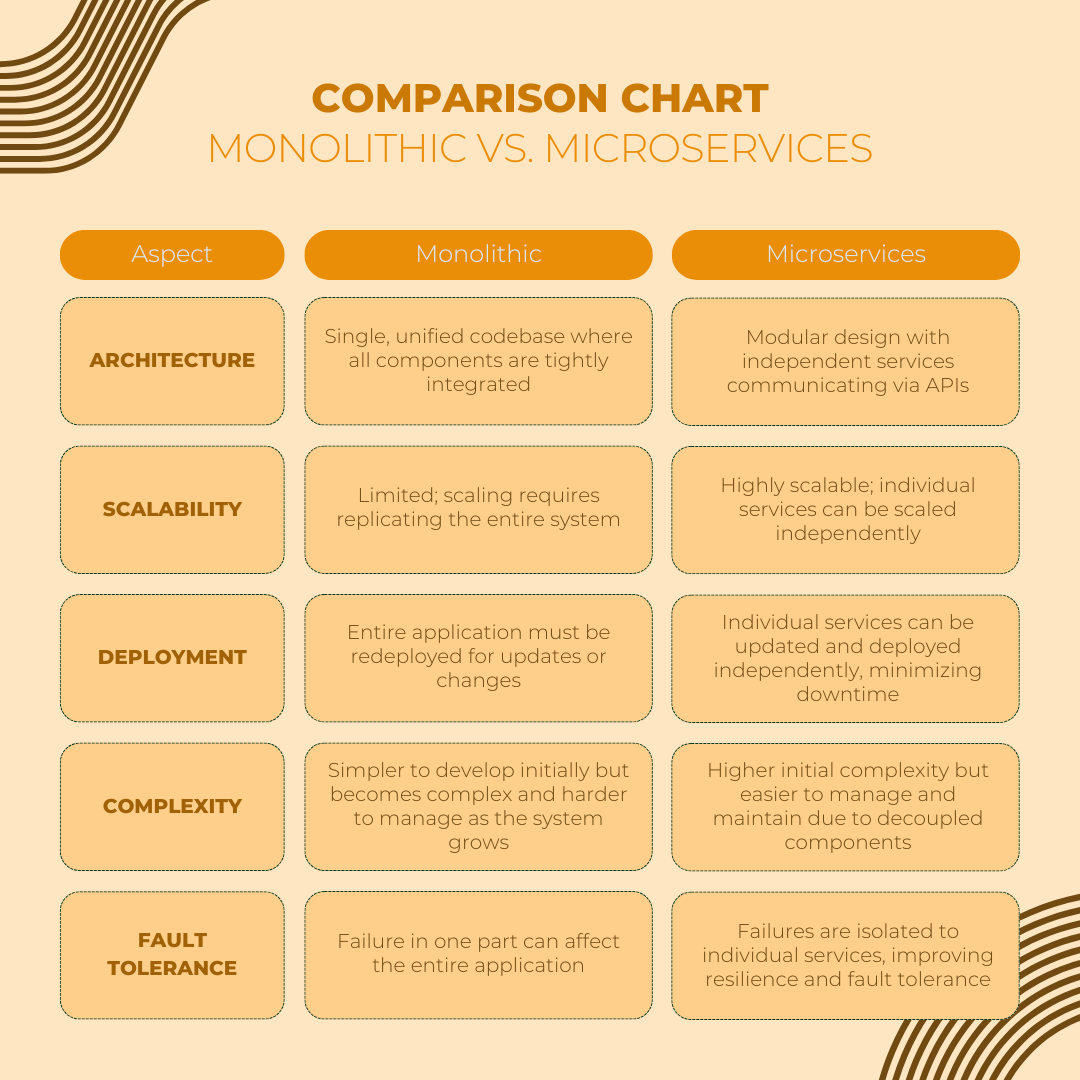Introduction
In the rapidly changing landscape of software development, traditional monolithic architectures frequently fail to keep up. These systems face significant scalability and deployment challenges, leading to development bottlenecks and maintenance issues.
As demands for flexibility and speed grow, microservices have emerged as a powerful solution, offering modularity and enhanced scalability. This article explores the shift from monolithic to microservices architectures, highlighting the evolution of platform engineering and its impact on modern software development.
Historical Background
The landscape of software engineering has undergone significant transformation over the decades, with architectural approaches evolving to meet the growing demands of technology.
In the early days of computing, software was built using monolithic architectures. These systems were characterized by a single, unified codebase where all components were interconnected, which made development straightforward but limited scalability and flexibility.
Monolithic architectures gained popularity due to their simplicity and ease of deployment. During this period, applications were often built as large, self-contained units where every component, from the user interface to the database, was tightly integrated.
This approach allowed for rapid development and deployment in the early stages of computing when software needs were less complex.
As software systems became more complex, the constraints of monolithic architectures became increasingly clear. The complexity of these systems increased with every new feature or change, leading to development bottlenecks and slower release cycles.
As applications became larger and more intertwined, updating or scaling a single component often required redeploying the entire system, which was both time-consuming and prone to errors.
Recognizing these challenges, the industry began seeking alternatives that could offer greater flexibility and scalability. This quest for improvement laid the groundwork for the emergence of platform engineering and the transition to microservices.
Understanding this historical context is crucial to appreciating the benefits and impact of microservices in addressing the shortcomings of traditional monolithic architectures.
The Challenges of Monolithic Architectures
Monolithic architectures, while effective in the early days of software development, present several challenges as systems scale and evolve. One of the key challenges is scalability.
In a monolithic system, all components are interconnected, making it difficult to scale individual parts of the application independently. As user demand grows, scaling requires replicating the entire system, which can be inefficient and costly.
Development bottlenecks also arise from the monolithic approach. Since all components are closely linked, modifying one part of the system can lead to unexpected effects on other parts.
This interdependency slows down the development process, as even minor updates necessitate extensive testing and coordination among teams. The complexity of managing a single codebase with multiple developers can lead to reduced productivity and increased risk of errors.
Deployment complications further exacerbate the challenges of monolithic architectures. Deploying updates or new features often requires redeploying the entire application, which increases the risk of downtime and disrupts service continuity. This monolithic deployment model can hinder the ability to roll out incremental improvements or hotfixes quickly.
Maintenance and technical debt are also significant concerns. As a monolithic application evolves, its codebase can become increasingly tangled, leading to technical debt and making the system harder to maintain. Debugging issues within a monolithic codebase can be cumbersome, and making changes or introducing new features can become increasingly complex and error-prone over time.
These challenges highlight the need for more modular and scalable solutions, paving the way for the adoption of microservices as a more flexible and efficient alternative to monolithic architectures.
The Emergence of Platform Engineering
As the limitations of monolithic architectures became increasingly apparent, platform engineering emerged as a strategic response to address these challenges and enhance software development practices.
Platform engineering focuses on creating and managing the underlying infrastructure and tools that support the development, deployment, and operation of software systems. This shift marked a significant evolution in how applications are designed and maintained.
Platform engineering introduced the concept of breaking down large, monolithic systems into smaller, manageable components, paving the way for the adoption of microservices.
Microservices architecture enables the creation of separate services that can be developed, deployed, and scaled independently. This modular approach contrasts sharply with the monolithic model, offering greater flexibility and agility in managing complex applications.
The transition from monoliths to microservices was driven by several key technological advancements. Containerization technologies, such as Docker, enabled the encapsulation of applications and their dependencies into isolated units that can run consistently across different environments.
This innovation addressed many deployment challenges associated with monolithic architectures. Additionally, Continuous Integration and Continuous Deployment (CI/CD) practices streamlined the development and release processes, allowing for more frequent and reliable updates.
The rise of microservices was also supported by the development of orchestration tools like Kubernetes, which manage the deployment, scaling, and operation of containerized applications. These tools provided the necessary infrastructure to support a microservices architecture, making it easier for organizations to adopt and manage.
Overall, platform engineering represents a significant shift towards more scalable, flexible, and efficient software development practices. It addresses the shortcomings of monolithic systems by leveraging modern technologies and practices to improve the way applications are built, deployed, and maintained.
Understanding Microservices Architecture
Microservices architecture represents a paradigm shift from traditional monolithic systems, emphasizing modularity and independence in software design. At its core, microservices architecture involves breaking down applications into smaller, self-contained services that communicate over well-defined APIs. Each service focuses on a specific business capability and operates independently, allowing for more scalable and flexible application development.
The primary principles of microservices include decoupling, modularity, and service-oriented design. By decomposing applications into discrete services, teams can develop, deploy, and scale each component independently.
This modular approach contrasts with monolithic architectures, where changes to one part of the application can impact others. In microservices, each service can be updated or scaled without affecting the entire system, promoting greater agility and faster iterations.
One of the most significant benefits of microservices is enhanced scalability. Services can be scaled individually based on their specific demands, allowing for efficient resource utilization. This capability is particularly advantageous for handling variable workloads and optimizing performance.
Furthermore, microservices enable teams to adopt different technologies and frameworks for each service, fostering innovation and flexibility.
Microservices also improve resilience and fault tolerance. Since services operate independently, the failure of one service does not necessarily impact the entire application. This isolation reduces the risk of widespread system failures and allows for more robust error handling and recovery mechanisms.
Real-world applications of microservices have demonstrated their effectiveness in addressing the limitations of monolithic systems. Leading companies have successfully implemented microservices to enhance their software architecture, achieving improved scalability, resilience, and flexibility.
Understanding these principles and benefits underscores the value of microservices in modern software development and highlights its role in advancing platform engineering.
Implementing Microservices
Transitioning to a microservices architecture involves several strategic considerations and best practices to ensure a successful implementation. The design of a microservices architecture begins with defining clear service boundaries.
Each microservice should encapsulate a specific business capability and interact with other services through well-defined APIs. This modular approach allows for independent development, testing, and deployment, reducing interdependencies and streamlining operations.
Designing a microservices architecture requires attention to various factors, such as data management and communication. Services often need to handle their own data stores, which can involve complex data synchronization and consistency challenges. Strategies like event-driven architectures and eventual consistency are commonly used to manage these challenges and ensure reliable data flow across services.
Despite its benefits, implementing microservices is not without its challenges. One significant obstacle is managing service communication. Microservices often interact through APIs, which necessitates robust API management and monitoring to ensure performance and security. Service discovery and load balancing are also critical components, as they facilitate the efficient routing of requests to the appropriate services.
Another challenge is managing the increased operational complexity that comes with microservices. The distributed nature of microservices can complicate monitoring, logging, and debugging. To address this, organizations often use comprehensive monitoring tools and distributed tracing to gain visibility into service interactions and performance.
Various tools and technologies support the implementation of microservices. Containerization platforms like Docker simplify the deployment of microservices by encapsulating them in portable containers.
Kubernetes, a leading orchestration tool, manages the deployment, scaling, and operation of containerized applications, providing essential infrastructure for maintaining a microservices architecture.

Future Trends in Platform Engineering
As platform engineering continues to evolve, several key trends are shaping its future, driving innovation and redefining how software systems are designed, developed, and operated.
Evolution of Microservices
Microservices architecture remains at the forefront of platform engineering, but its evolution is marked by increased sophistication. The focus is shifting towards optimizing microservices for performance and efficiency, including the adoption of service meshes that manage communication between services, enhance security, and improve observability.
Additionally, advances in API management and governance are streamlining interactions between microservices, making it easier to manage complex systems.
Role of AI and Automation
Artificial Intelligence (AI) and automation are becoming integral to platform engineering. AI-driven tools are enhancing capabilities in monitoring, anomaly detection, and predictive analytics, enabling proactive management of complex systems.
Automation, through Infrastructure as Code (IaC) and CI/CD pipelines, is simplifying deployment and scaling processes, reducing manual intervention, and accelerating development cycles. These technologies are fostering more efficient and intelligent platform management.
Integration with Emerging Technologies
The integration of microservices with emerging technologies is driving new possibilities in platform engineering. For instance, serverless computing is gaining traction, offering a way to run microservices without managing infrastructure, which can lead to cost savings and improved scalability.
Edge computing is also becoming significant, as it brings computation closer to data sources, reducing latency and enabling real-time processing. Additionally, the rise of quantum computing could eventually influence how complex computations are handled in the future.
Emphasis on Security and Compliance
With the increasing complexity of microservices and distributed systems, security and compliance are becoming more critical. The future of platform engineering will likely see a greater emphasis on integrating security into the development lifecycle, adopting zero-trust models, and ensuring compliance with regulations across diverse environments.
Key Takeaways
- Shift to Microservices: The transition from monolithic architectures to microservices offers improved scalability, flexibility, and resilience for modern applications.
- Modular Design: Microservices architecture breaks applications into independent services, allowing for independent development, deployment, and scaling.
- Technological Advancements: Containerization, CI/CD, and orchestration tools like Docker and Kubernetes are essential for managing microservices effectively.
- Real-world Impact: Companies like Netflix and Amazon have successfully adopted microservices to enhance performance and agility, demonstrating its practical benefits.
- Future Trends: Emerging trends include AI-driven automation, serverless computing, and edge computing, which are shaping the future of platform engineering.
Conclusion
The shift from monolithic to microservices architecture represents a significant evolution in platform engineering. Microservices address the scalability and flexibility limitations of monolithic systems by breaking applications into independent, manageable services. Key technologies like containerization, CI/CD, and Kubernetes facilitate this transition, enhancing deployment efficiency and system performance.
Real-world examples from companies such as Netflix and Amazon highlight the practical benefits of microservices, including improved scalability and agility. Looking ahead, trends like AI-driven automation and serverless computing will continue to shape the future of platform engineering, driving further innovation and efficiency. Adopting these innovations is essential for maintaining competitiveness in the ever-changing tech environment.

